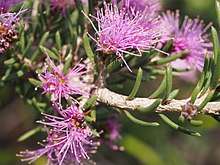Melaleuca papillosa
Melaleuca papillosa is a plant in the myrtle family, Myrtaceae and is endemic to the south-west of Western Australia. It is one of the smallest species of Melaleuca, distinguished by its narrow, usually hairy, pimply leaves, small heads of pink to purple flowers surrounded by silky hairs and scattered rather than clustered fruits.


| Melaleuca papillosa | |
|---|---|
 | |
| Melaleuca papillosa leaves and flowers | |
| Scientific classification | |
| Kingdom: | Plantae |
| Clade: | Tracheophytes |
| Clade: | Angiosperms |
| Clade: | Eudicots |
| Clade: | Rosids |
| Order: | Myrtales |
| Family: | Myrtaceae |
| Genus: | Melaleuca |
| Species: | M. papillosa |
| Binomial name | |
| Melaleuca papillosa | |
Description
Melaleuca papillosa is a shrub sometimes growing to 1.2 m (4 ft) tall. Its leaves are arranged alternately and are 6.5–14.5 mm (0.3–0.6 in) long, 1.0–1.7 mm (0.04–0.07 in) wide, linear to very narrow egg-shaped and semi-circular in cross section. The leaves are more or less curved, usually covered with short, matted, silky hairs and have small, pimply projections.[1][2]
The flowers are a shade of pink to purple and arranged in heads on the ends of branches which continue to grow after flowering and sometimes also in the upper leaf axils. The heads are up to 18 mm (0.7 in) in diameter with up to 3 groups of flowers in threes. The petals are 1.0–1.2 mm (0.04–0.05 in) long and fall off as the flower matures. The outer surface of the floral cup (the hypanthium) is usually hairy and there are five bundles of stamens around the flower, each with 4 to 7 stamens. Flowering occurs mainly in September and October, and is followed by fruit which are woody, cup-shaped capsules, 3.8–5 mm (0.1–0.2 in) long, scattered along the stem.[1][2]
Taxonomy and naming
Melaleuca papillosa was first formally described in 1999 by Lyndley Craven in Australian Systematic Botany from a specimen collected in the Fitzgerald River National Park.[3][4] The specific epithet (papillosa) is derived from the Latin word papilla meaning "nipple"[5] referring to the pimply surface of the leaves.[1]
Distribution and habitat
Melaleuca papillosa occurs in the Fitzgerald River district[1][2] in the Esperance Plains biogeographic region.[6] It grows in mallee heath in rocky clay loam.[7]
Conservation
Melaleuca papillosa is listed as "not threatened" by the Government of Western Australia Department of Parks and Wildlife.[6]
References
- Brophy, Joseph J.; Craven, Lyndley A.; Doran, John C. (2013). Melaleucas : their botany, essential oils and uses. Canberra: Australian Centre for International Agricultural Research. p. 269. ISBN 9781922137517.
- Holliday, Ivan (2004). Melaleucas : a field and garden guide (2nd ed.). Frenchs Forest, N.S.W.: Reed New Holland Publishers. p. 252. ISBN 1876334983.
- "Melaleuca papillosa". APNI. Retrieved 6 June 2015.
- Craven, L. A.; Lepschi, B. J. (1999). "Enumeration of the species and infraspecific taxa of Melaleuca (Myrtaceae) occurring in Australia and Tasmania". Australian Systematic Botany. 12 (6): 894. doi:10.1071/SB98019.
- Brown, Roland Wilbur (1956). The Composition of Scientific Words. Washington, D.C.: Smithsonian Institution Press. p. 634.
- "Melaleuca papillosa". FloraBase. Western Australian Government Department of Parks and Wildlife.
- Paczkowska, Grazyna; Chapman, Alex R. (2000). The Western Australian flora : a descriptive catalogue. Perth: Wildflower Society of Western Australia. p. 396. ISBN 0646402439.
External links

